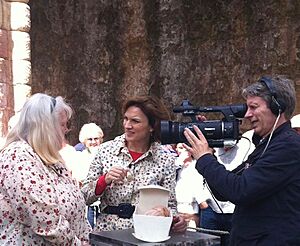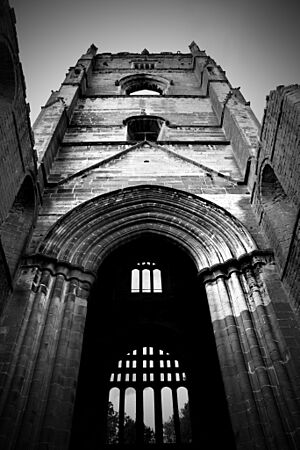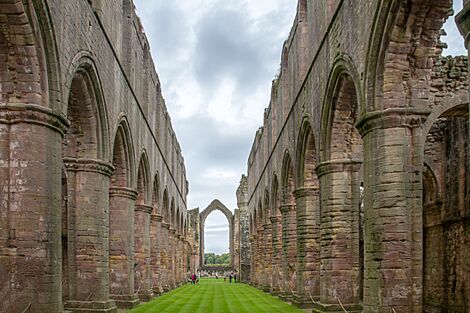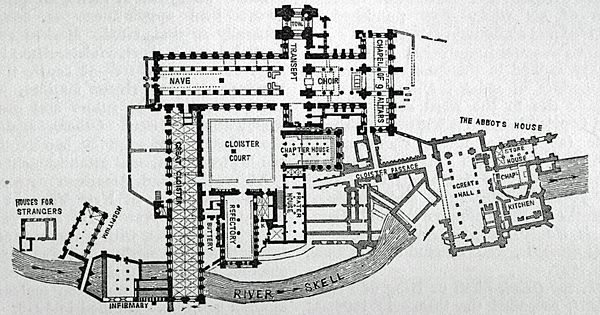Fountains Abbey facts for kids
Quick facts for kids Fountains Abbey and Studley Royal Water Garden |
|
|---|---|

Fountains Cistercian Abbey: River Skell, Tower & Chapel of Altars
|
|
| Location | Near Aldfield, North Yorkshire, England |
| Built | 1132 |
| Governing body | National Trust |
| Owner | National Trust |
| Website | https://www.nationaltrust.org.uk/fountains-abbey-and-studley-royal-water-garden |
| Official name: Studley Royal Park including the Ruins of Fountains Abbey | |
| Type | Cultural |
| Criteria | i, iv |
| Designated | 1986 (10th session) |
| Reference no. | 372 |
| Country | United Kingdom |
| Region | Europe and North America |
|
Listed Building – Grade I
|
|
| Official name: Fountains Abbey, with Ancillary Buildings | |
| Designated | 11 June 1986 |
| Reference no. | 1149811 |
| Lua error in Module:Location_map at line 420: attempt to index field 'wikibase' (a nil value). | |
Fountains Abbey is one of the biggest and best-preserved ruined monasteries in England. It was once home to Cistercian monks. You can find it about 3 miles (5 km) southwest of Ripon in North Yorkshire, near the village of Aldfield.
The abbey was started in 1132 and was active for 407 years. It became one of the richest monasteries in England. However, in 1539, Henry VIII ordered its closure during the dissolution of the monasteries.
Today, Studley Royal Park and the ruins of Fountains Abbey are owned by the National Trust. The abbey itself is looked after by English Heritage.
Contents
How Fountains Abbey Began
In 1132, a disagreement happened at St Mary's Abbey, York, a Benedictine monastery. Thirteen monks, including Saint Robert of Newminster, were asked to leave. Thurstan, the Archbishop of York, helped them. He gave them land in the valley of the River Skell.
This valley was a perfect spot for a monastery. It offered shelter, stone and wood for building, and fresh running water. The six springs on the site inspired the monks to name it Fountains.
After a very cold winter in 1133, the monks decided to join the Cistercian order. This was a fast-growing group of monks who wanted to live a simpler life. By 1135, Fountains became the second Cistercian monastery in northern England. The monks followed the rules of Clairvaux Abbey in France, led by St Bernard. A monk named Geoffrey of Ainai taught them Cistercian ways of prayer and how to build with wood.
Growing and Facing Challenges
Around 1143, Henry Murdac became the abbot. He replaced the small stone church and wooden buildings with new ones. The new church was similar to one he had helped build before. Within three years, a larger church and permanent stone buildings were ready.
In 1146, an angry crowd attacked the abbey and burned most of it down. This happened because they were upset with Abbot Murdac. But the monks quickly rebuilt and even started four new monasteries. Murdac later left to become the archbishop of York.
Richard, who became abbot in 1150, brought stability back to the abbey. He oversaw a big building project, fixing the damaged church and adding more rooms. By the time he passed away in 1170, the chapter house was finished, and the church was almost complete.
Later, in the late 1200s and early 1300s, the abbey faced tough times. Northern England was taxed more, and the abbey's income dropped. By the 1330s, Fountains Abbey was borrowing money instead of making a profit.
The Black Death plague hit in 1348–1349, causing huge losses of people and money. This nearly ruined the abbey. Another problem was the Papal Schism of 1378–1409, which caused confusion and arguments within the church.
Despite these difficulties, Fountains Abbey found some stability again. Abbots like John Greenwell (1442–1471) and Marmaduke Huby (1495–1526) helped restore the buildings. Abbot Huby even added a new tower, known as Huby's Tower, which you can still see today.
The last abbot, William Thirsk, was removed from his position. He was later involved in a protest called the Pilgrimage of Grace and faced serious consequences. He was replaced by Marmaduke Bradley, who surrendered the abbey to Henry VIII in 1539. This marked the end of Fountains Abbey as a working monastery.
Amazing Architecture
The abbey grounds covered about 70 acres (28 hectares) and were surrounded by an 11-foot (3.4-meter) wall. The River Skell flows through the site, dividing it into different areas. The church and main monastery buildings were in the center.
The first church was made of wood, but it was quickly replaced with stone. After being damaged in 1146, it was rebuilt even larger. This new church, finished around 1170, was 300 feet (91 meters) long. Abbot Huby added a tall, 160-foot (49-meter) tower just before the abbey closed. This tower is in an unusual spot at the north end of the church.
The cloister, a covered walkway, was in the middle of the monastery, south of the church. It had beautiful black marble and white sandstone arches. Around the cloister were important rooms like the chapter-house (where monks met), the warming house, the refectory (dining hall), and the kitchens.
A huge, vaulted building called the cellarium ran parallel to the cloister. It was used for storage and had a dining hall for the lay brothers (monks who did manual labor). At the southwest corner, the latrines (toilets) were built over the fast-flowing river.
The infirmary, where sick monks were cared for, was to the east. It started as a small building but grew into a grand dwelling with large windows and fireplaces. It even had its own chapel and kitchen.
To the west of the cloister were guest houses for visitors. To the east of the abbey was the monks' cemetery. In 2016, ground-penetrating radar helped discover hundreds of graves there, arranged neatly.
How the Abbey Made Money
Medieval monasteries like Fountains Abbey relied on landed estates given to them. They earned money from rents and gifts. At first, Cistercian monks avoided owning mills or collecting tithes because they wanted to keep their lives simple.
When Archbishop Thurstan founded the abbey, he gave them 260 acres (105 hectares) of land at Sutton and 200 acres (81 hectares) at Herleshowe. This helped them get started. In the early years, the monks struggled, but then a rich man named Hugh joined them, bringing money, furniture, and books.
By 1135, they had acquired more land. After the fire in 1146, the monks had established several granges (farm estates) nearby. A water mill was built on the abbey site to grind grain from these farms.
In October 2021, the National Trust found the foundations of a large 12th- to 13th-century tannery (a place for making leather) near the River Skell. This shows the abbey had industrial-scale operations.
The abbey continued to gain more land through gifts and purchases. By 1265, Fountains had a very profitable estate. They had farms, urban properties in cities like York, and other businesses like mining, quarrying, and fishing.
The monks and their lay brothers worked hard to manage these lands, including the rivers and woods. However, events like the Battle of Bannockburn in 1314, which led to Scottish raids, and a decrease in lay brothers, caused problems. The abbey started leasing out some of its properties.
By 1535, Fountains Abbey was involved in 138 villages. Its total income was £1,115, making it the richest Cistercian monastery in England before its closure.
After the Abbey Closed
After the abbey was closed, the land and buildings were taken by the King. On October 1, 1540, they were sold to Sir Richard Gresham. He was a Member of Parliament and a former Lord Mayor of London.
Later, in 1597, Sir Stephen Proctor bought the site and built Fountains Hall. The estate was then owned by the Messenger family for many years. They sold it to William Aislabie, who combined it with the Studley Royal Estate.
Visiting Fountains Abbey Today
Fountains Abbey is a Grade I listed building and is owned by the National Trust. It is part of the Studley Royal Park including the Ruins of Fountains Abbey, which is a UNESCO World Heritage Site.
Archaeological digs at the site began in 1846. In 1983, the National Trust bought the 674-acre (273-hectare) Fountains Abbey and Studley Royal estate.
World Heritage Site Status
In 1986, the parkland and abbey were named a World Heritage Site by UNESCO. This means it's recognized as a "masterpiece of human creative genius" and an "outstanding example of a type of building or landscape which shows important stages in human history."
National Trust Care
The National Trust owns Fountains Abbey and Studley Royal Park. English Heritage helps maintain the abbey. The trust also manages St Mary's Church, which is part of the World Heritage Site. In 2010, Fountains Abbey was one of the first National Trust places to be featured on Google Street View.
Exhibitions and Displays
Fountains Mill was the abbey's corn mill, built in the mid-1100s. It used waterwheels powered by the River Skell. It later became a sawmill and then generated electricity until 1928. In 2000, it was opened as an exhibition space.
The Porter's Lodge, once the abbey's gatehouse, now has an exhibition. It tells the story of Fountains Abbey and how the monks lived. A highlight is a large model of the abbey as it looked before it closed.
Protecting the Abbey from Floods
Since 2006, managing World Heritage Sites includes thinking about climate change. In early 2021, the National Trust shared that the abbey is at risk from flooding. There have been several floods, especially in 2007, that damaged the ruins and water garden.
Money from the National Lottery Heritage Fund is helping with the Skell Valley Scheme. This project aims to improve 12 miles (19 km) of the River Skell to reduce the risk of future floods.
Fountains Abbey in Pop Culture

Fountains Abbey has been a popular location for films and TV shows.
- In 1981, the band Orchestral Manoeuvres in the Dark filmed their music video for "Maid of Orleans (The Waltz Joan of Arc)" here.
- It was the setting for Alan Bennett's play A Day Out in 1972.
- Parts of Omen III: The Final Conflict (1980), Life at the Top, The Secret Garden (1993), The Secret Garden (2020), and The History Boys were filmed at the abbey.
- In 2020, scenes for the second season of the Netflix show The Witcher were filmed here.
- Other TV shows like Flambards, A History of Britain, and Gunpowder have also used the abbey as a backdrop.
Gallery
See also
 In Spanish: Abadía de Fountains para niños
In Spanish: Abadía de Fountains para niños
- Listed buildings in Lindrick with Studley Royal and Fountains
- Grade I listed buildings in North Yorkshire (district)
- List of Cistercian abbeys in Britain
- List of monasteries dissolved by Henry VIII of England
- Stonemasonry
- Studley Royal Park



















